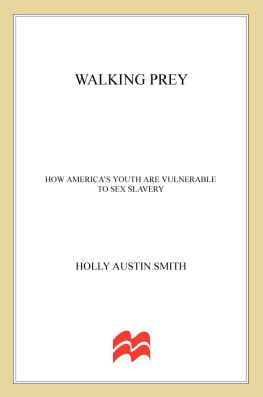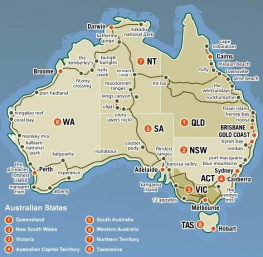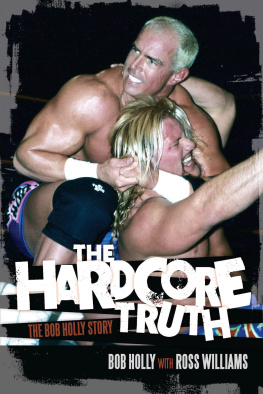Walking Prey
How Americas Youth Are Vulnerable to Sex Slavery
Holly Austin Smith
Foreword by Mira Sorvino

To my school teachers.
And to all the teachers who strive to lift
their students to the greatest heights possible.
The author and publisher have provided this e-book to you for your personal use only. You may not make this e-book publicly available in any way. Copyright infringement is against the law. If you believe the copy of this e-book you are reading infringes on the authors copyright, please notify the publisher at: us.macmillanusa.com/piracy.
WALKING PREY
Copyright Holly Austin Smith, 2014
All rights reserved.
For information, address St. Martins Press, 175 Fifth Avenue, New York, N.Y. 10010.
First published in 2014 by PALGRAVE MACMILLAN in the U.S.
a division of St. Martins Press LLC, 175 Fifth Avenue, New York, NY 10010.
ISBN: 978-1-137-27873-9
Our eBooks may be purchased in bulk for promotional, educational, or business use. Please contact the Macmillan Corporate and Premium Sales Department at 1-800-221-7945, ext. 5442, or by e-mail at .
Library of Congress Cataloging-in-Publication Data
Smith, Holly Austin.
Walking prey: how Americas youth are vulnerable to sex slavery / Holly Austin Smith.
pages cm
ISBN 978-1-137-27873-9 (hardback)
1. Child prostitutionUnited States. 2. Child traffickingUnited States. 3. Sexually abused childrenUnited States. 4. Sex crimesUnited StatesPrevention. I. Title.
HQ144.S657 2014
362.760973dc23
2013033088
A catalogue record of the book is available from the British Library.
Design by Letra Libre
First edition: March 2014
10 9 8 7 6 5 4 3 2 1
Printed in the United States of America.
Contents
Foreword
I first met Holly Smith at the National Conference of State Legislatures Fall Forum in Washington, D.C., December 2012. I was keynoting for the second time at one of their conferences, pushing for more and stronger anti-trafficking legislation on the state level, and I had asked the National Survivor Network, created by the Coalition to Abolish Slavery & Trafficking, if they had a member that lived near the conference. I felt very strongly that a survivor of human trafficking would be her or his own best advocate, and boy did she prove me right.
Holly walked on stage, a lovely, professional-looking blonde woman, looking every bit the part of a conservative politicians daughter. She then further disarmed the audience by projecting a picture of her fourteen-year-old self hanging out with her young friends. Any preconception that underage sex trafficking could only happen to other peoples children flew right out the window.
The story Holly briefly outlined that day, and has further detailed in this book, is painful, ugly, yet familiar. She systematically builds her case that just by being a child in Americain this culture obsessed with consumerism, sex, and the objectification of womenanyone is potentially vulnerable to being trafficked for sex or falling prey to CSEC (commercial sexual exploitation of children). Add to that the terrible insecurity that often accompanies adolescence, a need for love and escape from painful home environments, and Hollys young self reads an awful lot like how I remember feeling at thirteen and fourteen. She then factors in various elements such as prior sexual abuse, parental substance abuse, and an economic need that make her falling into the hands of a pimp trafficker almost unsurprising, if terrible.
She details all the steps that led her to that fateful situation, and is very clear that though she was not held at gunpoint, this was the only option she felt at the time was a viable means of surviving, of having some modicum of power, love, and attention, though she soon found out these were illusory. We are brought into the thought processes of a very young person, and are shown how pimp traffickers and gang traffickers have systematized how to take advantage of young people.
Holly has a unique way of making the extremely personal resonate on a universal level. Then she takes the research and science on predisposing factors and environments and folds them seamlessly with vetted best practices into sound recommendations. One, for preventing vulnerable children from being trafficked, and two, for successfully treating survivors so they are able to fully move forward and away from the cycle of sex trafficking. In all of this we are continually reminded that she knows whereof she speaks, because she knows exactly what did and did not work for her, and what could have been done better. She shines a light on survivor and non-survivor led methods of outreach prevention and aftercare that should be emulated, and replicated, on a national scale.
She focuses the light on the buyers of underage sex, and how any attempt to eradicate this system must focus on reaching these very average men, in every community, who pay for sex everyday with young people and who not only think nothing of it, but suffer very few consequences. Programs to target these current consumers have to be implemented, but it cant stop there. A culture of empathy must be engendered here, and the advertising culture that sexualizes young kids, and especially girls as objects (sometimes even as objects of abuse), must be changed. Boys have to be raised to respect and honor girls and women, not to exploit them.
One of the kinds of legislation that I continually advocate the robust passage of is Safe Harbor. What this involves is a new lens for law and order to view underage victims of sex trafficking and kids in commercial sexual exploitation. Essentially, it replaces the old criminal designation of child prostitute with minor victim of sex trafficking or sexual exploitation. It recognizes that children and teens in these situations are being used and abused by adults who exploit and profit from them, and that they are not criminals but victims, due a full gamut of services that help them reclaim their lives and move forward. It raises the criminal penalties of the traffickers to the highest levels, requiring sentencing commensurate with the other most serious crimes such as arson, rape, and murder. It expunges criminal records, so that child victims will not be haunted by their past throughout their lives, as they pursue higher education and gainful employment. In its best form it allows the minor victims to seek civil redress.
These laws are in harmony with the United States Federal Government and the United Nations Palermo Protocols official recognition that anyone under the age of eighteen does not need to provide evidence of force, fraud, or coercion to be deemed a victim of human trafficking. It is based upon the understanding that a child or teen does not have the legal, psychological, neurological, or emotional capacity to make an informed choice to be sexually exploitedso any assertion by law enforcement, the court system, or the youth themselves that their presence in prostitution or commercial sexual exploitation is by their own will is invalidated. Sadly, only 11 of 50 states had some version of the Safe Harbor legislation in 2012; and some of those were weak, meaning that in many states youth in commercial sexual exploitation are still deemed child prostitutes and considered criminals. It is overwhelmingly the child victims who are arrested, not the pimp and not the john, i.e., the adult buying their young bodies for sex. Policemen without crucial training for child sex trafficking still see these kids as bad seeds; and sometimes they end up not only in the juvenile system, but in adult jail, though they are minors and have not committed serious crimes.
In other cases child victims are diverted to mandatory treatment programs, where they are locked up and forced to complete the programs in order to avoid criminal charges. Although these programs are well-meaning, there is a serious flaw in their philosophy of treating victims like criminals given a second chance. In no other crime are its victims locked up. It is a serious dilemma because authorities fear for the minors wellbeing and fear they will fall back into the hands of traffickers. Holly debates the pros and cons of this approach. I think we all feel there is an ideal approach out there, just not perfected and put into place in a widespread enough way to do good at present.
Next page











